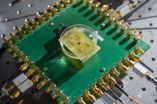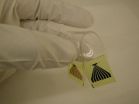(Press-News.org) Without administering a simple blood test in the first few days after surgery, 85 percent of the heart attacks or injuries patients suffer could be missed, according to a study in the March issue of Anesthesiology. Globally, more than 8 million adults have heart attacks or injuries after surgery every year, and 10 percent of those patients die within 30 days.
The study suggests a new diagnosis, Myocardial Injury after Noncardiac Surgery (MINS), would be useful to physicians because of its broader definition from what is traditionally used to diagnose heart attacks now. The study authors note that by using the traditional definition of heart attack, more than 50 percent of the serious heart attacks or injuries that happen after surgery will go undetected, seriously affecting a patient's chances of surviving 30 days past surgery.
The study found that only 15 percent of patients who have heart attacks after surgery experience traditional symptoms such as chest pain and pressure, shortness of breath or pain in the neck, jaw or arm.
"Most surgical patients who suffer a heart attack or injury will do so within the first 48 hours after surgery," said P.J. Devereaux, M.D., Ph.D., head of cardiology and the Perioperative Cardiovascular Clinical Program at the Juravinski Hospital and Cancer Centre, Hamilton Health Sciences, Hamilton, Ontario and lead study author. "During this time, most of these patients are typically taking pain medications, which can mask the symptoms of a serious heart injury."
For the first three days following surgery, more than 15,000 patients older than 45 who were having non-cardiac surgery, had a simple blood test to measure troponin, a protein specific to the heart that is released into the blood when the heart muscle is injured. Patients with an elevated level of troponin were given an EKG to also assess heart damage.
The study found that only 15 percent of patients who suffered heart attacks or injury after surgery experienced chest pain or other heart attack symptoms. Without monitoring troponin concentrations, 85 percent of those who suffered heart attacks or injury would have gone undetected. The study also found that of all the post-surgical complications, heart attack or injury is the most common reason patients die within 30 days of surgery. Ten percent of patients who suffer a heart attack after surgery will die within 30 days.
"The ease and feasibility of the test to detect heart injury point to tremendous opportunities for designing clinical studies to test novel interventions for attenuation (or reduction) of myocardial injury and perioperative mortality," noted Karsten Bartels, assistant professor, department of anesthesiology, University of Colorado School of Medicine, Denver, in an accompanying editorial.
INFORMATION:
The American Society of Anesthesiologists
Founded in 1905, the American Society of Anesthesiologists (ASA) is an educational, research and scientific society with more than 52,000 members organized to raise and maintain the standards of the medical practice of anesthesiology. ASA is committed to ensuring physician anesthesiologists evaluate and supervise the medical care of patients before, during and after surgery to provide the highest quality and safest care every patient deserves.
For more information on the field of anesthesiology, visit the American Society of Anesthesiologists online at asahq.org. To learn more about the role physician anesthesiologists play in ensuring patient safety, visit asahq.org/WhenSecondsCount. Join the social conversation today. Like ASA on Facebook, follow ASALifeline on Twitter.
85 percent of heart attacks after surgery go undetected due to lack of symptoms
Can be identified with simple blood test
2014-02-18
ELSE PRESS RELEASES FROM THIS DATE:
Chance of falling after knee replacement not increased by regional anesthesia
2014-02-18
Two types of regional anesthesia do not make patients more prone to falls in the first days after having knee replacement surgery as some have previously suggested, according to a study based on nearly 200,000 patient records in the March issue of Anesthesiology.
Regional forms of anesthesia – spinal or epidural (neuraxial) anesthesia and peripheral nerve blocks (PNB) – which only numb the area of the body that requires surgery, provide better pain control and faster rehabilitation and fewer complications than general anesthesia, research shows. But some surgeons avoid ...
Obese patients who feel judged by doctors are less likely to shed pounds, study shows
2014-02-18
Overweight and obese people who feel their physicians are judgmental of their size are more likely to try to shed pounds but are less likely to succeed, according to results of a study by Johns Hopkins researchers.
The findings, reported online last week in the journal Preventive Medicine, suggest that primary care doctors should lose the negative attitudes their patients can sense if the goal is to get patients with obesity to lose 10 percent or more of their body weight — an amount typically large enough to reduce blood pressure, cholesterol and diabetes risk.
"Negative ...
Medicaid's 'tube-tying' polices create roadblocks for low-income women
2014-02-18
PRINCETON, N.J.—Tubal ligation – commonly referred to as having one's "tubes tied" – is widely used to prevent unintended pregnancies. However, current Medicaid policies create roadblocks for low-income women trying to obtain the procedure, according to a review written by researchers at Princeton University's Woodrow Wilson School and other U.S. institutions.
Under a Medicaid rule enacted in 1978, women must currently wait 30 days after signing a written consent form to obtain a tubal ligation. This requirement is prohibitive for many women who want to receive the ...
Can marijuana protect the immune system against HIV and slow disease progression?
2014-02-18
New Rochelle, NY, February 18, 2014—New evidence that chronic intake of THC, the primary psychoactive ingredient in marijuana, can protect critical immune tissue in the gut from the damaging effects of HIV infection is reported in AIDS Research and Human Retroviruses, a peer-reviewed journal from Mary Ann Liebert, Inc., publishers. The article is available free on the AIDS Research and Human Retroviruses website at http://www.liebertpub.com/aid.
Patricia Molina and coauthors from Louisiana State University Health Sciences Center, New Orleans, report that chronic THC administration ...
Solar-induced hybrid fuel cell produces electricity directly from biomass
2014-02-18
Although low temperature fuel cells powered by methanol or hydrogen have been well studied, existing low temperature fuel cell technologies cannot directly use biomass as a fuel because of the lack of an effective catalyst system for polymeric materials.
Now, researchers at the Georgia Institute of Technology have developed a new type of low-temperature fuel cell that directly converts biomass to electricity with assistance from a catalyst activated by solar or thermal energy. The hybrid fuel cell can use a wide variety of biomass sources, including starch, cellulose, ...
Quest for jellyfish robot leads to discovery of bending rules for animal wing, fin tips
2014-02-18
WOODS HOLE, Mass. —A Navy-sponsored project to design a biologically inspired, swimming jellyfish robot has led scientists to the surprising discovery of common bending rules for the tips of wings, fins, flukes, mollusk feet, and other propulsors across a broad range of animal species.
The study, led by John H. Costello of Providence College and the Marine Biological Laboratory (MBL) in Woods Hole, where he is a visiting scientist, is published this week in Nature Communications.
By studying videos of 59 different animals—from fruit flies to humpback whales—propelling ...
Single chip device to provide real-time 3-D images from inside the heart, blood vessels
2014-02-18
Researchers have developed the technology for a catheter-based device that would provide forward-looking, real-time, three-dimensional imaging from inside the heart, coronary arteries and peripheral blood vessels. With its volumetric imaging, the new device could better guide surgeons working in the heart, and potentially allow more of patients' clogged arteries to be cleared without major surgery.
The device integrates ultrasound transducers with processing electronics on a single 1.4 millimeter silicon chip. On-chip processing of signals allows data from more than a ...
'Legal highs,' PMMA and zombie panic
2014-02-18
Recent deaths in both Canada and the UK linked to PMA/PMMA in ecstasy pills has brought public scrutiny to this little known drug. With Canadian producing most of the ecstasy in the North American market, this timely paper (Ecstasy, legal highs and designer drug use: A Canadian perspective) published this week in Drug Science Policy and Law looks at trends in ecstasy adulteration, the facts around PMA/PMMA-linked deaths and explores alternatives to the endless banning of new drugs.
It finds:
In 2007, according to the Health Canada Drug Analysis Service, only 3% of seized ...
A stretchable highway for light
2014-02-18
WASHINGTON, Feb. 18, 2014—For futuristic applications like wearable body sensors and robotic skin, researchers need to ferry information along flexible routes. Electronics that bend and stretch have become possible in recent years, but similar work in the field of optics – communicating with light instead of electrons – has lagged behind. Particularly difficult to engineer have been optics that stretch, lengthening when someone wearing body sensors bends to tie their shoe, or when a robotic arm twists through a full range of motion.
Now a team of Belgian researchers reports ...
Georgia Tech study reveals copyright complexities, social norms in online media creation
2014-02-18
In the age of mashups, fan fiction and content sharing, online media creation has spurred new complexities in copyright, effectively turning the legal concept of "fair use" on its ear, according to a new study from Georgia Tech.
Research into fan fiction and other types of remix communities reveals many legal misconceptions persistent among different groups when applying copyrighted work to their own creations. The research also highlights online social norms – independent of actual law – that guide the use of copyrighted works in fan communities.
For the study, Georgia ...
LAST 30 PRESS RELEASES:
New study overturns long-held model of how plants coordinate immune responses.
New AI model predicts disease risk while you sleep
Scientists discover molecular ‘reshuffle’ and crack an 80-year-old conundrum
How stressors during pregnancy impact the developing fetal brain
Electrons lag behind the nucleus
From fungi to brain cells: one scientist's winding path reveals how epigenomics shapes neural destiny
Schizophrenia and osteoporosis share 195 genetic loci, highlighting unexpected biological bridges between brain and bone
Schizophrenia-linked genetic variant renders key brain receptor completely unresponsive to both natural and therapeutic compounds
Innovative review reveals overlooked complexity in cellular energy sensor's dual roles in Alzheimer's disease
Autism research reframed: Why heterogeneity is the data, not the noise
Brazil's genetic treasure trove: supercentenarians reveal secrets of extreme human longevity
The (metabolic) cost of life
CFRI special issue call for papers: New Frontiers in Sustainable Finance
HKU Engineering scholar demonstrates the smallest all-printed infrared photodetectors to date
Precision empowerment for brain "eavesdropping": CAS team develops triple-electrode integrated functional electrode for simultaneous monitoring of neural signals and chemical transmitters during sleep
Single-capillary endothelial dysfunction resolved by optoacoustic mesoscopy
HKU three research projects named among ‘Top 10 Innovation & Technology News in Hong Kong 2025’ showcasing excellence in research and technology transfer
NLRSeek: A reannotation-based pipeline for mining missing NLR genes in sequenced genomes
A strand and whole genome duplication–aware collinear gene identification tool
Light storage in light cages: A revolutionary approach to on-chip quantum memories
Point spread function decoupling in computational fluorescence microscopy
BacPhase: Long-insert paired-end sequencing for bin marker construction and genome phasing
GmWOX1 regulates the mediolateral polarity of compound leaves in soybean
ChargeFabrica: An open-source simulation tool that aims to accelerate search for high performance perovskite solar cells
High levels of ADAR overexpression induce abundant and stochastic off-target RNA editing in rice protoplasts
On-demand upgraded recycling of polyethylene and construction of sustainable multifunctional materials based on the "LEGO" strategy
New "Stomata in-sight" system allows scientists to watch plants breathe in real-time
Anorexia nervosa may result in long-term skeletal muscle impairment
Narrative-based performance reviews deemed fairest by employees
New insights reveal how advanced oxidation can tackle emerging water pollutants
[Press-News.org] 85 percent of heart attacks after surgery go undetected due to lack of symptomsCan be identified with simple blood test






